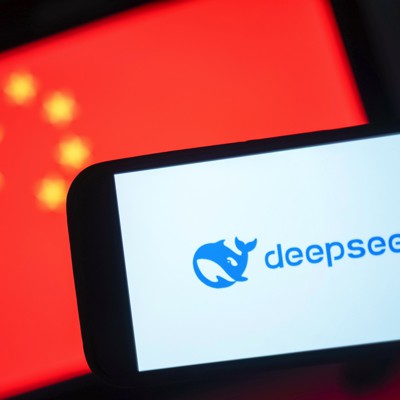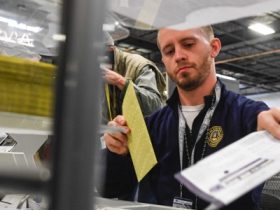During this year’s Lunar New Year celebrations, a remote village in China’s Guangdong province became an unexpected center of attention. Crowds of visitors flocked to the hometown of DeepSeek’s founder, Liang Wenfeng, eager to glimpse the modest house where one of China’s most influential AI pioneers had grown up. Once an unremarkable rural enclave, the village was now decorated with banners reading, “Welcome home, Wenfeng—your hometown is proud of you!”
The celebrations contrasted sharply with the U.S. reaction to the Hangzhou-based company’s announcement of a ChatGPT-like AI tool: “a collective wail from the White House, Wall Street and Silicon Valley.” For U.S. political leaders, it was, as President Trump said, a “wakeup call” that China could not just compete, but maybe leap ahead in key technologies with major national security implications. It poked a hole in the self-confident narrative of the handful of U.S. tech oligarchs who increasingly drive domestic politics. And it shocked stock markets, sparking a sell-off among major AI firms over $1 trillion.
But to Chinese policymakers and defense analysts, DeepSeek means far more than local pride in a hometown kid made good. They view it as a breakthrough that reinforces China’s strategic autonomy and reshapes the balance of power in the U.S.-China AI competition. By demonstrating an ability to innovate under sanctions, bypass Western technological barriers, and accelerate AI advancements on its own terms, China has sent a stark message: it can and will compete at the highest levels of AI development.
Beijing believes DeepSeek will not only reduce its reliance on Western technology but lay the groundwork for an AI ecosystem that could challenge U.S. leadership in commercial and military domains. The implications thus extend far beyond technology, raising urgent questions about the future of global AI governance, economic competition, and security stability.
Chinese commentators have described DeepSeek’s development as a direct rebuttal to U.S. efforts to constrain China’s AI progress through chip-export restrictions. Pan Helin, an expert with China’s Ministry of Industry and Information Technology, hailed DeepSeek as a testament to the country’s ability to chart an independent technological course, circumventing reliance on U.S. semiconductor supply chains. China’s Science and Technology Daily boasted that, unlike previous models that relied on high-end NVIDIA GPUs, DeepSeek’s architecture employs cost-efficient innovations, allowing it to function effectively without cutting-edge Western hardware. A prominent Chinese financial information and services platform wrote that it has lowered the barriers to AI development in China, enabling a more distributed and resilient AI ecosystem.
This is an incomplete narrative, of course. Chinese state media does not mention that DeepSeek’s current architecture primarily used NVIDIA H800 GPUs (which comply with U.S. export restrictions by limiting interconnect bandwidth more than advanced chips such as the H100), as well as likely relied on a stockpile of tens of thousands of NVIDIA chips for its earlier stages of training and development. Some speculate that DeepSeek may have accessed H100s and other restricted NVIDIA GPUs through intermediaries in Singapore, potentially bypassing U.S. export controls. These concerns have triggered investigations by U.S. authorities and Singaporean regulators. In any case, reports indicate that limited access to advanced AI chips may restrict DeepSeek’s future ability to compete with Western counterparts at the highest levels of performance — a limitation that its founder, Liang, has also acknowledged.
Regardless, DeepSeek’s breakthroughs in unsupervised learning and hybrid neural network architecture provide a competitive advantage, according to a prominent Chinese financial information and services platform. By optimizing model efficiency and reducing dependence on vast computational resources, DeepSeek has lowered the barriers to AI development in China, enabling a more distributed and resilient AI ecosystem. This shift is described as having profound implications for China’s long-term strategic resilience, reducing its vulnerability to U.S. sanctions while reinforcing the credibility of its self-reliance doctrine.
Furthermore, DeepSeek appears to validate the CCP’s strategy of catalyzed growth within China’s AI supply chain. The Chinese government has long provided state funding for AI research at national and provincial levels, and promoted regulatory frameworks that prioritize indigenous innovation. Beyond this most recent success, China Daily noted that domestic component production for AI development has surged from 19 percent to 64 percent, reflecting a concerted effort to localize the entire AI ecosystem.
Not just a technological milestone
Other Chinese commenters have framed DeepSeek as not just a technological achievement, but a geopolitical statement. Hu Xijin, the nationalistic and outspoken former editor of Global Times, characterized DeepSeek’s success as evidence that U.S. sanctions have “failed to block China’s progress.” This goes deeper than just celebration. By positioning DeepSeek as a challenge to Western dominance, Beijing seeks to expand its influence in the international AI governance framework and counteract what it views as U.S. technological hegemony.
Chinese state media has promoted DeepSeek’s open-source model as an alternative to Western AI ecosystems, portraying China as a leader in global technological cooperation. DeepSeek’s development aligns with China’s broader strategy of AI-enabled soft power projection. The model’s superior Chinese-language processing capabilities and its adherence to state-mandated content controls reflect Beijing’s long-term ambition to establish AI as a vehicle for ideological influence. While Western models prioritize free-flowing information, DeepSeek’s strict censorship mechanisms ensure alignment with the Chinese Communist Party’s (CCP) official narratives, making it an attractive tool for Beijing’s global digital strategy and for use by any foreign authoritarian government partners.
Beyond its commercial and diplomatic significance, DeepSeek has been celebrated for its potential military applications. Chinese military analysts highlight DeepSeek’s ability to improve intelligent decision-making in combat scenarios, optimize weapons systems, and improve real-time battlefield analysis. Given China’s longstanding emphasis on civil-military fusion, the innovations powering DeepSeek could be integrated into military AI development, supporting autonomous weapons platforms, cyber warfare capabilities, and intelligence processing.
Xu Bingjun, a senior researcher at the Beijing-based Huayu think tank and the state-affiliated Liaowang Institute, wrote: “DeepSeek represents a paradigm shift in military AI, offering a cost-effective, high-performance solution that can revolutionize battlefield intelligence. Its ability to process vast amounts of data in real-time enhances strategic decision-making, reduces human error, and enables more effective deployment of autonomous systems.” The researcher further emphasized that DeepSeek’s low computational cost presents strategic advantages for China’s defense sector, as it allows for the training of advanced AI systems on consumer-grade hardware. This cost efficiency lowers the barriers to entry for AI adoption within China’s military-industrial complex, accelerating the People’s Liberation Army’s modernization drive and enhancing its ability to conduct AI-enabled warfare.
Chinese military analysts also claim that DeepSeek’s AI capabilities extend to multiple domains of military application. The system’s ability to analyze battlefield conditions in real time could improve situational awareness, enabling faster and more accurate command decisions. Moreover, its advanced reasoning and predictive modeling might optimize war-gaming simulations, helping commanders anticipate enemy movements and refine tactical responses. In autonomous combat, DeepSeek’s AI models may support the development of intelligent unmanned systems, such as drones, robotic ground units, and naval platforms, boosting China’s asymmetric warfare capabilities.
Xu also asserts that DeepSeek might provide an edge in network defense operations, using deep learning and anomaly detection to spot and neutralize cyber threats. Chinese cyber security firms, such as Qihoo 360, have already begun to incorporate DeepSeek’s AI models into their cyber security products. The system’s integration into China’s defense infrastructure could also enable more resilient communication networks, reinforcing command and control mechanisms in contested environments.
As AI-driven military applications move toward the center of modern warfare, Chinese analysts believe that DeepSeek’s rapid advancement signals a shift in the global balance of power in military AI. This could be an overstatement, not just because of its lesser performance compared to competing systems, but potential chip shortages that may handicap its adoption—though Chinese media argues these shortages have spurred domestic firms to pursue independent innovation.
However, it is this belief, in both China and the United States, about the importance of DeepSeek that may be as important as the underlying reality. A lesson from both China’s cognitive-warfare theories and the history of arms races is that perceptions often matter more. China’s now-proven ability to develop and deploy sophisticated AI solutions, and in ways that U.S. firms were unable to achieve first, doesn’t just challenge existing technological hierarchies. It has changed how Chinese leaders view their own capabilities and appears to have compelled the United States and its allies to reassess their strategic positioning in an accelerating AI arms race.
Tye Graham is a Senior Researcher with BluePath Labs and a retired U.S. Army Foreign Area Officer.
P.W. Singer is Strategist at New America and the author of multiple books on technology and security.
Read the full article here








Leave a Reply